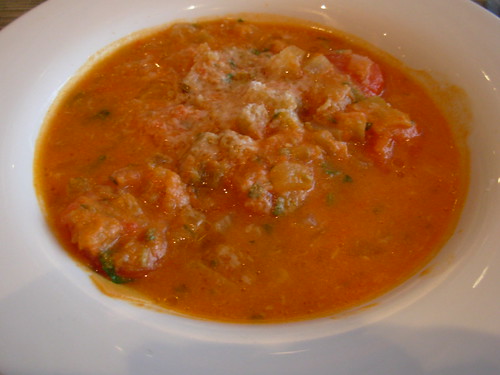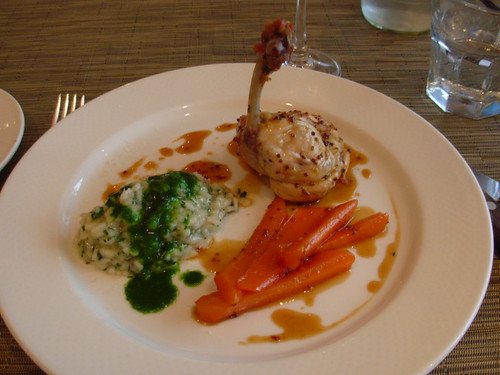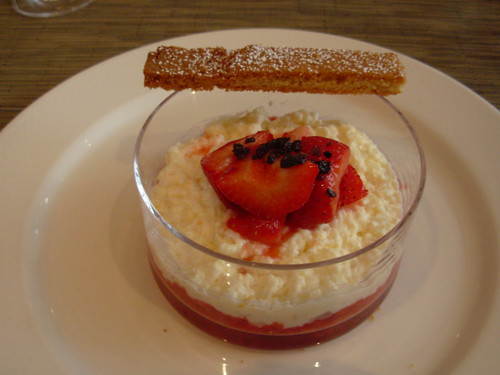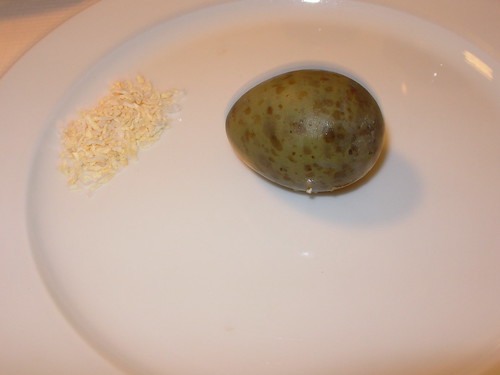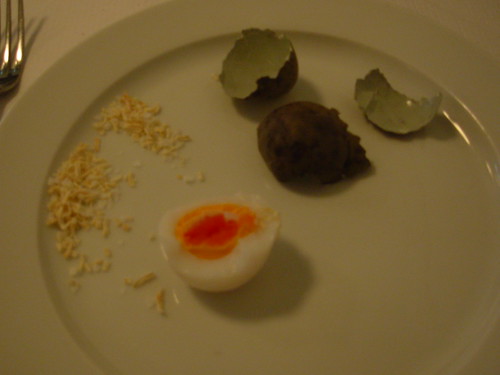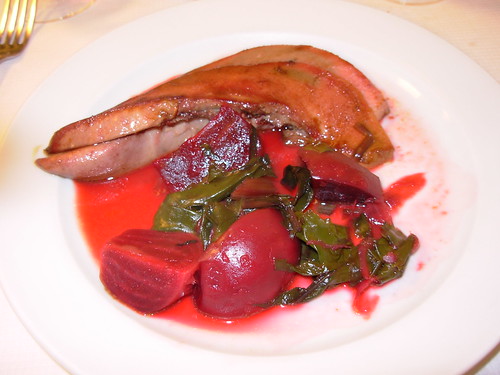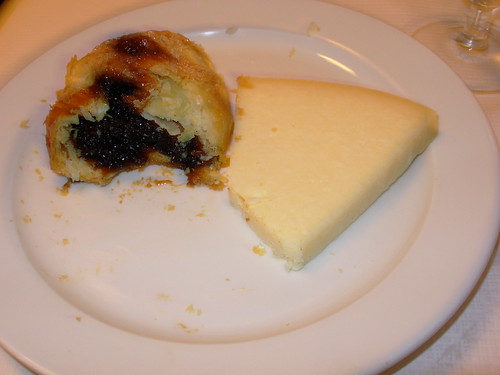The Crown at Whitebrook
It may be needlessly nasty to suggest that being the best restaurant in Wales is rather akin to being the leading intellectual pictured in Maxim or on Entertainment Tonight. If Americans think of Welsh cuisine at all, it is toasted cheese that comes to mind, prepared caerphilly, of course. The Welsh have some fine mountains, fields, and bays, of course – and many fine residents – some of whom prefer to dine in London - but they seem to have a preference for overcooked lamb and boiled leeks.
After two weeks of eating in Cardiff, a friend and I decided to drive through back, wet roads to the Crown at Whitebrook, a restaurant in Monmouthshire – on the English edge of Wales - that has recently received a Michelin star, one of two Welsh restaurants so honored, and the one rated by the Observer as the best restaurant in Wales. Under the direction of Chef James Sommerin, who has headed the kitchen for three years, after serving three years as sous chef, the Crown is the dining destination for those visited the Welsh capital.
The Crown at Whitebrook is not a restaurant of a kind that Americans find often. Hidden in a poetic corner of rustic Britain, it is a lengthy taxi ride from the train and about an hour from central Cardiff. Instead, the restaurant adjoins a rural hotel. The closest model in the United States might be the Inn at Little Washington, some distance outside the District of Columbia. The leading restaurants that dot Napa County have some of the same feel, except Napa operates as a tourist destination.
Guests are invited to arrive half an hour prior to dinner. We were a seated in a pleasantly comfortable hotel lounge, allowed to peruse the menu and wine list, and offered a drink. Such hospitality has its pleasures and drawbacks. The American diner typically arrives ready to go, go, go. Cooling one’s heels is not in our nature. Such slow time has blessings, but makes a long evening longer still.
Unlike urban boites, the décor of the Crown is decidedly muted, notably for creams and beiges and pale greens, set in country moderne. One is not expected to chew the architecture. More important is the graceful service. The servers, congenial and competent, are not the global nighthawks that urbanites have come to take for granted.
My only overarching complaint in what was a carefully composed and luxurious meal it was a de-emphasis of the savory. This was not true of each of the dishes, but many might have been goosed. We began with a set of four canapés. Least successful was a bland, and slightly watery, carrot-coriander soup that lacked strong carrot taste and much indication of coriander. In contrast the snip of fried haddock was a delightful chip of fish, beautifully prepared. Also stirring was a canapé of beet and goat cheese.
We were both startled and pleased by our amuse: a small bowl of chestnut soup with wild mushrooms and poached quail egg. It was as dense and woodsy as a late fall afternoon, served in mid-May. It certainly revealed the skills of our chef, even if it, too, was notable for a smooth and subtle flavor profile.
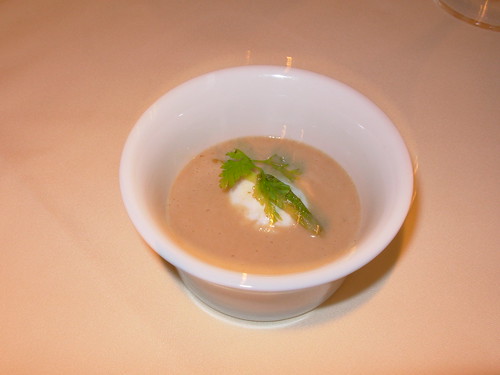
As an appetizer, I selected Roast Quail and Quail Confit with foie gras, beetroot, orange marmalade, and caramelized nuts. The dish was luscious and woodsy (again an autumnal dish). As a supporter of chefs who select bitter ingredients, I eagerly awaited the sting of the marmalade, but, again, it could have been used to greater effect. While the dish as prepared was not overly subtle, it could have been still more dramatic.
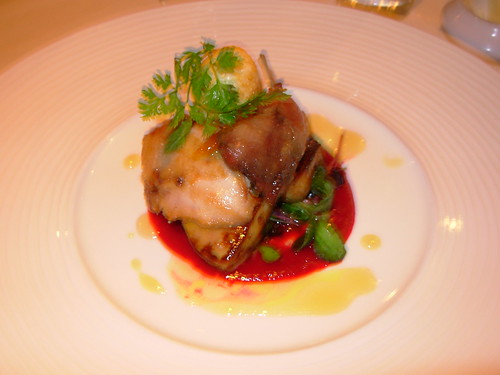
The entree was marinated loin of Welsh lamb with wild garlic, asparagus, lima beans, turnips, fresh morels (the smallest morels that I have (barely) seen, each tinier than a fingertip – little baby morels) with a sauce of licorice and black treacle. With my preferred flavor profile this was a dish that demanded my attention. The dish was complex, congenial, and impressively prepared, but again the licorice and treacle were back-tastes, rather than front and center as would have been more courageous. The idea of the dish was magnificent, the reality just slightly short of brilliant. Unlike the other dishes, this presentation – lamb, morels, asparagus – shouted spring. It was the most seasonal dish from a chef whose cuisine did not seem tied to the climate. My companion, ordering the line-caught seabass on artichoke barigule, sauce d’epice and Parmesan enjoyed the subtlety of the chef’s vision, but wished he had played a more savory hand.

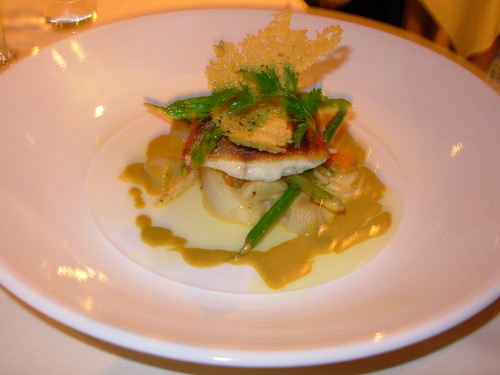
The palate cleaser was a dense raspberry gratine capped with a twenty-first century peach and vanilla foam. Unfortunately the foam was more airy than flavorful, and the raspberry cleansed the palate without foamy aid.
We closed with the recommended Coconut Parfait with Mango Espuna and Chilled Cucumber Soup. Of all the desserts I have recently tasted this was perhaps the oddest. The coconut panna cotta might have used a deeper tropical taste, but the mango provided this edge. The cucumber soup, an elegant and subtle touch, was mostly drowned out by the mango. All this was rather expected. However, the chef, gathering his bravado, added bits of carbonated crystallized sugar, surrounded by cocoa butter – Crackle Crystals as the British call them. Imagine a dessert made with Pop Rocks. It was as if a molecular imp had gained access to the kitchen when no one was guarding the pantry. If this were one of Hester Blumenthal tricks in a 20 course menu, I would have treasured the experience; in rural Wales I was simultaneously amused and puzzled at a moment that made diners April Fools.

Still, the Crown at Whitebrook is a serious dining destination, a kitchen to be reckoned with in London or New York, run by a young chef who is still refining his culinary vision. The food stops short of perfection, because of an unwillingness to commit the drama of taste, even when Chef Sommerin feints to embrace it. If one wishes to be edgy one must accept the danger head on. The Crown will surely deserve its second star at that moment that Chef Sommerin ramps up the licorice and saves his Crackle Crystals for tykes and toddlers.
The Crown at Whitebrook
Whitebrook, Nr Monmouth, Monmouth NP25 4TX United Kingdom
44-(0)1600-860254
http://www.crownatwhitebrook.co.uk
